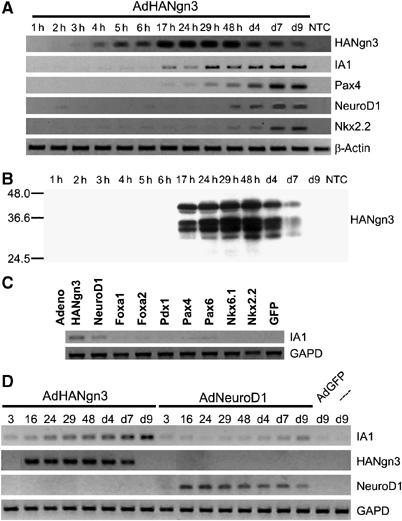Figure 1.

Rapid and specific induction of IA1 expression in AdHANgn3-transduced adult human duct cells. (A) RT–PCR analysis of gene expression in AdHANgn3-transduced duct cells. Exogenous Ngn3 is detected at 4 h following transduction. IA1 expression is noticed at 17 h following transduction, which is earlier than the proposed direct Ngn3 target genes Pax4, NeuroD1 and Nkx2.2. (B) Exogenous HANgn3 protein is detected at 17 h post-transduction. Expression levels rise until 48 h post-transduction, after which they gradually drop and become undetectable at day 9. (C) Activation of IA1 gene expression in adult human pancreatic duct cells is observed following transduction with either AdHANgn3 and, albeit much weaker, AdNeuroD1, but not with adenoviral Foxa1, Foxa2, Pdx1, Pax4, Pax6, Nkx6.1, Nkx2.2 and GFP. RNA was extracted at 7 days following transduction. (D) Time course of the induction of IA1 expression in adult human duct cells transduced with either AdHANgn3 or AdNeuroD1. Induction of endogenous IA1 starts at 16 h post-infection with AdHANgn3 until at least 9 days following transduction. In contrast, induction of endogenous IA1 by AdNeuroD1 is obvious only at 4 days following transduction. Background signal caused by DNA of the single exon IA1 gene. NTC, nontransduced control.
